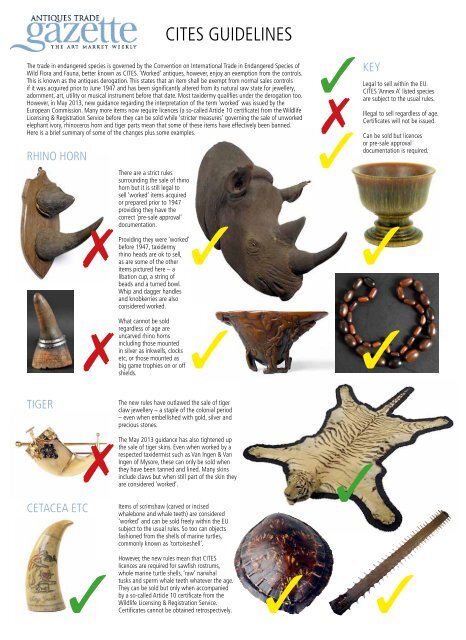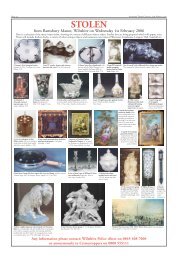atg cites pdf - Antiques trade gazette
atg cites pdf - Antiques trade gazette
atg cites pdf - Antiques trade gazette
You also want an ePaper? Increase the reach of your titles
YUMPU automatically turns print PDFs into web optimized ePapers that Google loves.
CITES GUIDELINES<br />
The <strong>trade</strong> in endangered species is governed by the Convention on International Trade in Endangered Species of<br />
Wild Flora and Fauna, better known as CITES. ‘Worked’ antiques, however, enjoy an exemption from the controls.<br />
This is known as the antiques derogation. This states that an item shall be exempt from normal sales controls<br />
if it was acquired prior to June 1947 and has been significantly altered from its natural raw state for jewellery,<br />
adornment, art, utility or musical instrument before that date. Most taxidermy qualifies under the derogation too.<br />
However, in May 2013, new guidance regarding the interpretation of the term ‘worked’ was issued by the<br />
European Commission. Many more items now require licences (a so-called Article 10 certificate) from the Wildlife<br />
Licensing & Registration Service before they can be sold while ‘stricter measures’ governing the sale of unworked<br />
elephant ivory, rhinoceros horn and tiger parts mean that some of these items have effectively been banned.<br />
Here is a brief summary of some of the changes plus some examples.<br />
RHINO HORN<br />
There are a strict rules<br />
surrounding the sale of rhino<br />
horn but it is still legal to<br />
sell ‘worked’ items acquired<br />
or prepared prior to 1947<br />
providing they have the<br />
correct ‘pre-sale approval’<br />
documentation.<br />
7 3<br />
Providing they were ‘worked’<br />
before 1947, taxidermy<br />
rhino heads are ok to sell,<br />
as are some of the other<br />
items pictured here – a<br />
libation cup, a string of<br />
beads and a turned bowl.<br />
Whip and dagger handles<br />
and knobkerries are also<br />
considered worked.<br />
7<br />
3<br />
KEY<br />
3Legal to sell within the EU.<br />
CITES ‘Annex A’ listed species<br />
are subject to the usual rules.<br />
Illegal to sell regardless of age.<br />
Certificates will not be issued.<br />
Can be sold but licences<br />
or pre-sale approval<br />
documentation is required.<br />
3<br />
7<br />
What cannot be sold<br />
regardless of age are<br />
uncarved rhino horns<br />
including those mounted<br />
in silver as inkwells, clocks<br />
etc, or those mounted as<br />
big game trophies on or off<br />
shields.<br />
3<br />
3<br />
TIGER<br />
7<br />
CETACEA ETC<br />
3<br />
The new rules have outlawed the sale of tiger<br />
claw jewellery – a staple of the colonial period<br />
– even when embellished with gold, silver and<br />
precious stones.<br />
The May 2013 guidance has also tightened up<br />
the sale of tiger skins. Even when worked by a<br />
respected taxidermist such as Van Ingen & Van<br />
Ingen of Mysore, these can only be sold when<br />
they have been tanned and lined. Many skins<br />
include claws but when still part of the skin they<br />
are considered ‘worked’.<br />
Items of scrimshaw (carved or incised<br />
whalebone and whale teeth) are considered<br />
‘worked’ and can be sold freely within the EU<br />
subject to the usual rules. So too can objects<br />
fashioned from the shells of marine turtles,<br />
commonly known as ‘tortoiseshell’.<br />
However, the new rules mean that CITES<br />
licences are required for sawfish rostrums,<br />
whole marine turtle shells, ‘raw’ narwhal<br />
tusks and sperm whale teeth whatever the age.<br />
They can be sold but only when accompanied<br />
by a so-called Article 10 certificate from the<br />
Wildlife Licensing & Registration Service.<br />
Certificates cannot be obtained retrospectively.<br />
3<br />
3 3
ELEPHANT IVORY<br />
7 7 7<br />
7<br />
The definition of what constitutes ‘worked’ elephant ivory<br />
has changed significantly under the new rules. For tusks or<br />
sections of tusks to be considered ‘worked’ they now need<br />
to be fully carved or shaped into a new form such as a<br />
paper turner. Even when tusks are polished and permanently<br />
mounted as part of a decorative or functional object they no<br />
longer qualify as worked.<br />
Four of the items pictured here would no longer qualify as<br />
the tusks essentially remain in their natural state. In short, if<br />
it looks like a raw tusk, it might be a problem.<br />
The tusk carved across its whole surface, and the section of<br />
tusk fashioned as a brush pot, are both permissible, as are<br />
the pair of tea caddies that are veneered in sheets of ivory.<br />
Painted sheets of cut ivory, such as a portrait miniature, are<br />
also considered worked.<br />
3<br />
OTHER SPECIES<br />
3 3<br />
ANTLERS & HORNS<br />
It is only the parts of species<br />
listed on CITES ‘Annex A’<br />
list that are problematic.<br />
The items pictured here (a<br />
silver cocktail shaker with<br />
a warthog tusk handle and<br />
three silver-mounted cow<br />
horn beakers) are permissible<br />
as the species used are not on<br />
3the endangered list.<br />
The vast majority of mounted horns and antlers (even big game trophies) do<br />
not pose a problem – unless the species is on the CITES ‘special status’ list. It<br />
is important to do some homework.<br />
The springbok, for example, is not on the CITES list so the horns below right<br />
can be sold. The horns below left are from a red deer stag and present no<br />
problem. However, the horns, below centre are from the Bawean deer, a<br />
critically endangered species of deer found only in the island of Bawean in<br />
Indonesia. These would require a certificate to be sold at auction.<br />
3 3 33<br />
Prepared September 2013 by Roland Arkell (rolandarkell@<strong>atg</strong>media.com) with the assistance of Kim McDonald of Taxidermy Law (kim@taxidermylaw.co.uk)






